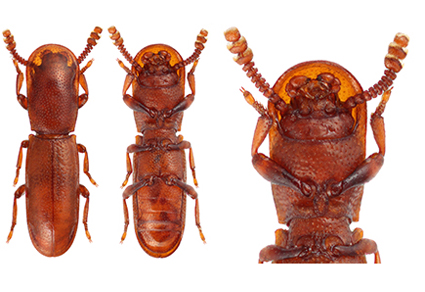Abstract
The second species of the enigmatic tenebrionid genus Microblattellus Ferrer, 2006, Microblattellus kakizoei sp. nov., is described from Cambodia. The type specimen was collected from a nest of the fungus-growing termite Macrotermes gilvus (Hagen, 1858). Although the genus is currently placed in the tribe Falsocossyphini, its assignment is highly doubtful, and its true systematic position remains uncertain.
References
- Bremer, H.J. (2014) Revision of Azarelius Fairmaire, Ziaelas Fairmaire and related Oriental termitophilous genera, with descriptions of two new genera and remarks on tribal placement (Coleoptera: Tenebrionidae: Amarygmini). Stuttgarter Beiträge zur Naturkunde A, Neue Serie, 7, 163–182.
- Bremer, H.J. & Lillig, M (2014) World catalogue of Amarygmini, Rhysopaussini and Falsocossyphini (Coleoptera; Tenebrionidae). Mitteilungen der Münchner Entomologischen Gesellschaft, 104 (Supplement), 3–176.
- Fedorov, A., Beichel, R., Kalpathy-Cramer, J., Finet, J., Fillion-Robin, J.C., Pujol, S., Bauer, C., Jennings, D., Fennessy, F., Sonka, M., Buatti, J., Aylward, S., Miller, J.V., Pieper, S. & Kikinis, R. (2012) 3D Slicer as an image computing platform for the Quantitative Imaging Network. Magnetic resonance imaging, 30, 1323–1341. https://doi.org/10.1016/j.mri.2012.05.001
- Ferrer, J. (2006) Constitution du groupe indo-african des Falsocossyphini, tribu nova, et description d’un nouveau genre hypogée du Vietnam. Coleoptera, Tenebrionidae. Cahiers Scientifiques. Centre de Conservation et d’Étude des collections. Muséum d’Histoire Naturelle de Lyon, 10, 75–83. https://doi.org/10.3406/mhnly.2006.1349
- Heller, K.M. (1918) Eine neue aberrante Eustrophinen-Gattung (Coleoptera: Melandryidae). Tijdschrift voor Entomologie, 60, 376–381, pl. 4. [1917]
- Hozawa, S. (1914) Note on a new termitophilous coleoptera found in Formosa (Ziaelas formosanus). Annotationes zoologicae Japonenses, 8, 483–488.
- Kistner, D.H. (1969) The biology of termitophiles. In: Krishna, K. & Weesner, F.M. (Eds.), Biology of termites. Vol. 1. Academic Press, New York, pp. 525‒557. https://doi.org/10.1016/B978-0-12-395529-6.50021-0
- Kistner, D.H. (1979) Social and evolutionary significance of social insect symbionts. In: Hermann, H.R. (Ed.), Social Insects. Vol. 1. Academic Press, New York, pp. 339‒413. https://doi.org/10.1016/B978-0-12-342201-9.50015-X
- Kistner, D.H. (1982) The social insects’ bestiary. In: Hermann, H.R. (Ed.), Social Insects. Vol. 3. Academic Press, New York, pp. 1–244. https://doi.org/10.1016/B978-0-12-342203-3.50008-4
- Metscher, B.D. (2009) MicroCT for comparative morphology: simple staining methods allow high-contrast 3D imaging of diverse non-mineralized animal tissues. BMC physiology, 9, 11. https://doi.org/10.1186/1472-6793-9-11
- Schawaller, W. (2013) The termitophilous genus Rhyzodina Chevrolat (Coleoptera: Tenebrionidae: Amarygmini): new data, species‐key, and remarks on antennal tufts of hairs. Deutsche Entomologische Zeitschrift, 60, 65–71.
- Pic, M. (1916) Notes et descriptions abrégées diverses. Mélanges exotico-entomologiques, 17, 2–8.


